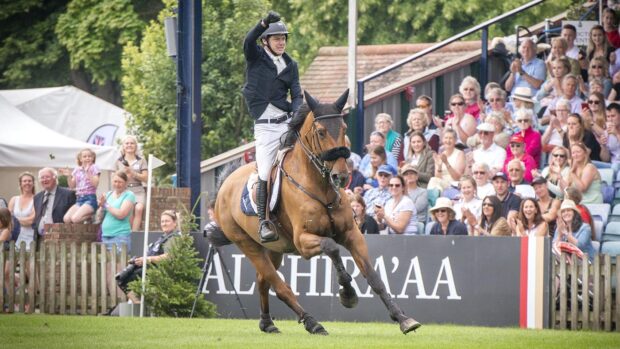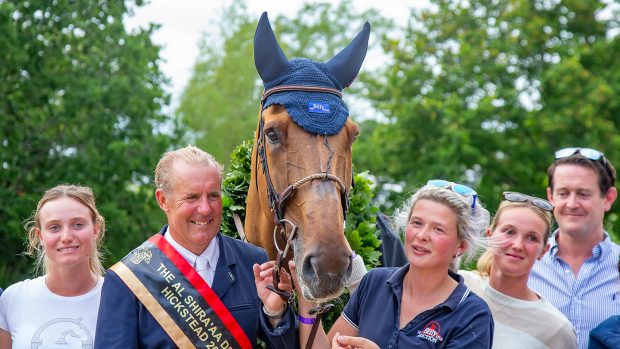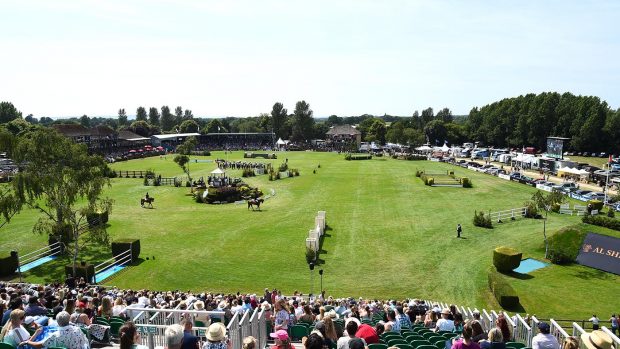The Hickstead Jumping Derby consists of 16 fences, with 22 jumping efforts, and is 1,195 metres long. Some fence dimensions have changed since 1961, but the course has otherwise stayed as Pam Carruthers – recently honoured by the FEI for services to the sport – and Douglas Bunn planned it.
Bunn first had the idea of building the famous course after seeing a film of the Hamburg Derby from before World War II. He flew to Germany and carefully measured the Hamburg bank, but it was covered in snow at the time, which is why the Hickstead bank is 9in higher.
The bank currently in situ in the International Arena is the second Derby Bank. The first version, which was constructed entirely of clay, was demolished and rebuilt nearer the edge of the international arena in 1970. The new bank has a concrete core coated in clay to avoid any slippage in the surface.
At 5ft 3in, the biggest fences are:
- Fence 4 – Black gate. This falls very easily, as it is on flat cups.
Fence 5 – Wall. Imposing, solid and usually jumps well.
Fence 7b – Second part of the road jump. This has a ditch in front and is set three strides from part one. If horses get on to the road jump, they usually jump off without many problems.
Fence 9 – White rails. One of the most influential fences. A vertical set two strides from the Derby Bank, to get it right you need luck when jumping off the bank.
Fence 12 – Derby rails. This fence is often used at Hickstead, but the square rails fall very easily. Most riders aim at the posts in between, to give the horse something to focus on.
Fence 14 – Balustrade. Has spoiled many otherwise great rounds. It is on a downhill run and horses are tiring.
The smallest fence on the course is the rail on top on the Derby Bank. But, as it is 3ft 5in high, it still takes jumping.
Apart from 15ft of open water, with no ground-line, the widest fences (6ft 6in) are the second, a true parallel that needs an accurate approach, and the final rustic parallel. With light poles, flat cups and tired horses by this stage, this falls all too easily.
Although not the biggest, the Devil’s Dyke is the most difficult fence. It is very close to the crowd and can seem like one huge effort to the horse. Due to the gradient, the horse probably has to clear 6ft over the final part.
Highlights of the Hickstead Derby meeting
Thursday, 3 June: 3pm Hickstead Derby Tankard
Friday, 4 June: 3pm Osborne Refrigerators Derby Trial
Saturday, 5 June: 1pm Gladwish Land Sales Speed Derby
Sunday, 6 June: 2.45pm DFS Derby
Hickstead showground is on the A23, 10 miles north of Brighton and 13 miles south of Gatwick Airport. Coaches go to Hickstead from London, Brighton and Gatwick.
The nearest railway stations are Burgess Hill (5 miles); Hassocks (5 miles) and Haywards Heath (7 miles). You can get taxis to the showground from these stations.
Tickets can be obtained on arrival at the showground or online from www.hickstead.co.uk
Thursday & Friday: general admission: £10 adult; £5 child/OAP; £25 family (2 adults, 2 children, 1 car).
Don’t miss Horse & Hound Online’s daily updates from the Hickstead Jumping Derby. Full coverage of the meeting will also be published in Horse & Hound.



